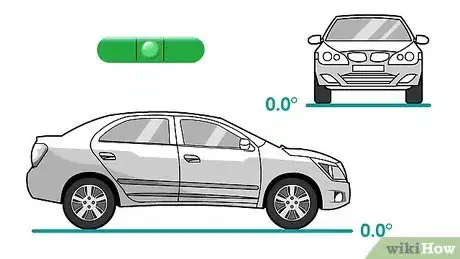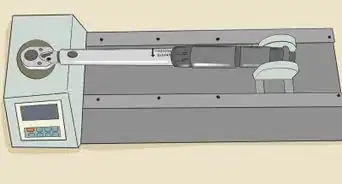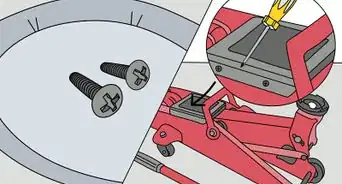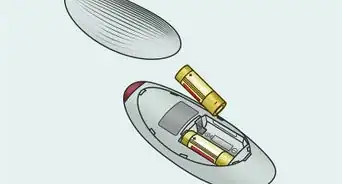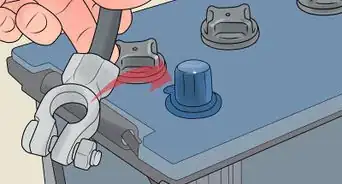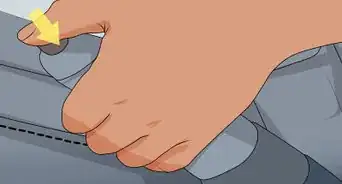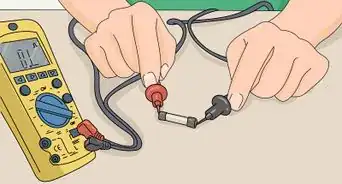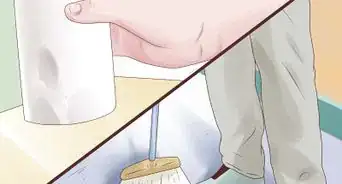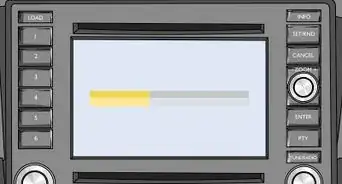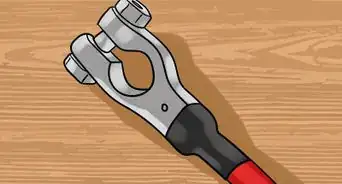This article was co-authored by Duston Maynes and by wikiHow staff writer, Hunter Rising. Duston Maynes is an Automotive Repair Specialist at RepairSmith. Duston specializes in leading a team that handles a variety of automotive repairs including replacing spark plugs, front and rear brake pads, fuel pumps, car batteries, alternators, timing belts, and starter motors. Duston holds an Associate’s degree in Automotive/Diesel Technology from The Universal Technical Institute of Arizona and is a Certified Diagnostic Technician and Automobile Mechanics Technician through BMW STEP. RepairSmith received The 2020 Big Innovation Award by Business Intelligence Group and The Startup of the Year by the American Business Awards. RepairSmith was also included in Built in LA’s 50 Startups to Watch and The Business Intelligence Group’s 52 Names Leading the Way in Customer Service. RepairSmith offers in-home services to provide car owners convenient and complete auto repair everywhere.
There are 11 references cited in this article, which can be found at the bottom of the page.
This article has been viewed 500,517 times.
While you can replace a tire just using a car jack, you should use jack stands when doing any work underneath your vehicle. Jack stands provide a sturdier base and support the weight of your vehicle easily. When using jack stands, make sure to place them at your vehicle's pinch points or on its frame to keep them from slipping. Once you're finished with your work, lift your vehicle up and slide the stands out from underneath, and you're set to drive!
Steps
Lifting Your Vehicle
-
1Find a flat, level surface to park your vehicle. Work on a clean, paved area so your vehicle is on even ground. Avoid jacking your vehicle in a place that's bumpy, near heavy traffic, or covered in gravel. Make sure each side of your vehicle is level so the jack or jack stands can't slip out from underneath it.
- Working in a garage or a flat driveway is the best place to lift your vehicle.
-
2Activate your vehicle's parking brake. Find the lever in your vehicle that controls your parking brake and pull it until it's activated. The parking brake will ensure your vehicle doesn't lurch forwards or backwards while you jack it.
- Place chocks, or tire wedges, around each of your wheels if you're lifting up the back end of your car. If you don't have tire wedges, you can use 2 in × 4 in (5.1 cm × 10.2 cm) boards in front of and behind your wheels.
Advertisement -
3Locate an area underneath your vehicle to place your floor jack. Use hydraulic floor jack for the safest way to lift your vehicle. Slide the floor jack underneath your vehicle so the arm is underneath the frame of your vehicle or at a lift point.[1]
- Don't use a scissor jack since they are less stable and only meant for emergency situations like changing a tire.
- Consult with your vehicle's manual to determine the best place to jack it.[2]
-
4Raise your vehicle so the tires are 2–3 in (5.1–7.6 cm) off the ground. Crank the handle up and down to lift your vehicle off of the ground. Continue lifting your vehicle until the tire or tires closest to your jack are completely off the ground.[5]
- Don't lift your car higher than you need or else it could be unstable on the jack.
Placing the Jack Stands
-
1Set the jack stand underneath the pinch points of your vehicle. The pinch points are located on the sides of your vehicle behind your front tires or in front of your rear tires. Slide your jack stand in from the side of your vehicle. Line up the divot on your jack stand with the part of the pinch point that extends down.[6]
- If your vehicle doesn't have pinch points, set the jack stands underneath the vehicle's frame.
- Don't crawl underneath your vehicle while it's jacked until you have stands secured in place.
Tip: Check the weight of your vehicle in the manual or online. Make sure your jack stands can support that amount of weight before using them.
-
2Adjust the height of the jack stand if you need to. If you have an adjustable jack stand, lift the top of the jack stand up until it's touching the pinch point on your vehicle. Once you've changed the height of the stand, put the safety pin attached to the stand through the hole at the base to secure it place. That way, it won't fall down when the weight of your vehicle is placed on it.[7]
- Always place the safety pin in your jack stand, or else the vehicle could fall on top of you while you're underneath it.
- Some jack stands cannot be adjusted. If yours doesn't change height, you can skip this step.
-
3Lower your vehicle slowly onto the jack stand. Slowly turn the lever on your floor jack counterclockwise to drop your vehicle back down. The jack stand will support the weight on the side of your vehicle so you can safely work underneath it. Pull the jack out from underneath your vehicle.[8]
- If you have room underneath your vehicle, keep the jack in place for additional security.
-
4Push your vehicle slightly to make sure it's sturdy. Give your vehicle a small nudge to see if it moves around or shifts its weight. The jack stand and your vehicle shouldn't move when you push it. If it does, avoid going underneath the vehicle and try to place the jack stand in a new area.[9]
-
5Place additional jack stands to lift your vehicle completely off the ground. Continue jacking up your vehicle on each side and sliding jack stands underneath the pinch points. Make sure the stands on opposite sides are straight across from one another so your vehicle is sturdy. Once you've placed the jack stands you need, you can start working underneath your vehicle.
- Make sure any adjustable jack stands are the same height so your vehicle doesn't sit crooked.
Removing the Stands
-
1Raise your vehicle 1 in (2.5 cm) above your jack stand. When you're finished working, roll your floor jack back underneath your vehicle so it's in line with the lift point you used. Crank the lever up and down to lift the vehicle up so you can pull out the jack stand easily.[10]
-
2Pull the jack stand out from the side of your vehicle. Reach underneath your vehicle from the side and slide your jack stand out. Don't crawl underneath the front or back of your vehicle while removing jack stands since it's only being supported by the jack.[11]
- Don't adjust the height of your jack stand until it's out from under your vehicle.
-
3Lower the jack until your vehicle is back on the ground. Turn the lever on your floor jack counterclockwise to slowly lower your vehicle. Once your tires are back on the ground, roll your jack out from under your vehicle.[12]
- Hold the lever on your floor jack low to the ground so the bottom of your vehicle doesn't bump into it.
-
4Continue to lift your vehicle and remove the stands until you've got them all. Place your jack underneath the lift points and raise your vehicle on each side if you need to remove additional jack stands. If you jacked your vehicle completely off the ground, remove both of the jack stands from the front before removing the ones in back.
Expert Q&A
-
QuestionWhere do I place my jack stands?
 Duston MaynesDuston Maynes is an Automotive Repair Specialist at RepairSmith. Duston specializes in leading a team that handles a variety of automotive repairs including replacing spark plugs, front and rear brake pads, fuel pumps, car batteries, alternators, timing belts, and starter motors. Duston holds an Associate’s degree in Automotive/Diesel Technology from The Universal Technical Institute of Arizona and is a Certified Diagnostic Technician and Automobile Mechanics Technician through BMW STEP. RepairSmith received The 2020 Big Innovation Award by Business Intelligence Group and The Startup of the Year by the American Business Awards. RepairSmith was also included in Built in LA’s 50 Startups to Watch and The Business Intelligence Group’s 52 Names Leading the Way in Customer Service. RepairSmith offers in-home services to provide car owners convenient and complete auto repair everywhere.
Duston MaynesDuston Maynes is an Automotive Repair Specialist at RepairSmith. Duston specializes in leading a team that handles a variety of automotive repairs including replacing spark plugs, front and rear brake pads, fuel pumps, car batteries, alternators, timing belts, and starter motors. Duston holds an Associate’s degree in Automotive/Diesel Technology from The Universal Technical Institute of Arizona and is a Certified Diagnostic Technician and Automobile Mechanics Technician through BMW STEP. RepairSmith received The 2020 Big Innovation Award by Business Intelligence Group and The Startup of the Year by the American Business Awards. RepairSmith was also included in Built in LA’s 50 Startups to Watch and The Business Intelligence Group’s 52 Names Leading the Way in Customer Service. RepairSmith offers in-home services to provide car owners convenient and complete auto repair everywhere.
Automotive Repair Specialist Look over your owner's manual to find the proper jack points for your vehicle.
Look over your owner's manual to find the proper jack points for your vehicle. -
QuestionIs it safe to work under a car on jack stands?
 wikiHow Staff EditorThis answer was written by one of our trained team of researchers who validated it for accuracy and comprehensiveness.
wikiHow Staff EditorThis answer was written by one of our trained team of researchers who validated it for accuracy and comprehensiveness.
Staff Answer wikiHow Staff EditorStaff AnswerIf they are used correctly, yes. Never work under a car supported by just a jack, and don’t try to adjust the height of the jack stands using wood blocks or other boosters, since they could slip off.
wikiHow Staff EditorStaff AnswerIf they are used correctly, yes. Never work under a car supported by just a jack, and don’t try to adjust the height of the jack stands using wood blocks or other boosters, since they could slip off. -
QuestionHow many jack stands do I need?
 wikiHow Staff EditorThis answer was written by one of our trained team of researchers who validated it for accuracy and comprehensiveness.
wikiHow Staff EditorThis answer was written by one of our trained team of researchers who validated it for accuracy and comprehensiveness.
Staff Answer wikiHow Staff EditorStaff AnswerUse 2 if you only need to lift 1 end of the car. If you need to support the whole car, use 4 jack stands.
wikiHow Staff EditorStaff AnswerUse 2 if you only need to lift 1 end of the car. If you need to support the whole car, use 4 jack stands.
Warnings
- Never go underneath your vehicle without jack stands. Car jacks could slip and the vehicle will fall on top of you.⧼thumbs_response⧽
- Make sure your parking brake is activated and your wheels are chocked so your vehicle doesn't roll away when you start jacking it.⧼thumbs_response⧽
- The information in this article is intended to provide general answers for frequently asked questions about this topic, and may not be applicable to all vehicles. Please refer to your vehicle’s owner’s manual for details about maintenance intervals and other vehicle specifications. If you are unsure about your ability to perform any repair, we recommend contacting a certified automotive technician to perform the necessary work.⧼thumbs_response⧽
Things You'll Need
- Floor jack
- Jack stands
References
- ↑ https://youtu.be/8OyzbGDn6xg?t=269
- ↑ Duston Maynes. Automotive Repair Specialist. Expert Interview. 11 June 2021.
- ↑ https://youtu.be/8OyzbGDn6xg?t=153
- ↑ https://youtu.be/8OyzbGDn6xg?t=173
- ↑ https://youtu.be/8OyzbGDn6xg?t=269
- ↑ https://youtu.be/8OyzbGDn6xg?t=284
- ↑ https://youtu.be/STw3evrUoSU?t=14
- ↑ https://youtu.be/xLFn_bMkZc0?t=380
- ↑ https://youtu.be/8OyzbGDn6xg?t=453
About This Article
To use jack stands, start by activating your vehicle's parking brake and jacking up the vehicle with a hydraulic floor jack so the tires are 2-3 inches off the ground. Then, slide your jack stand in from the side of the vehicle, and line up the divot on the stand with one of your vehicle's pinch points, which are located behind the tires on the sides. Next, slowly lower your vehicle onto the jack stand. Finally, nudge your vehicle to see if it moves around at all. If it does, try placing the jack stand in a new area. To learn how to remove jack stands, scroll down!
